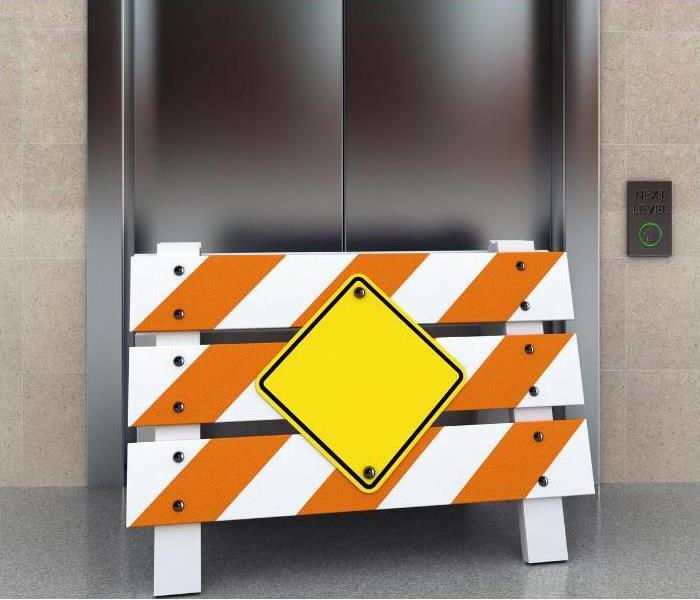Elevator Water Damage? 7 Step Property Management Guide
5/3/2021 (Permalink)
Elevators are not designed to operate in water.
If you are a property manager, it is important to handle all of the necessary repairs that come up. One of the most common types of damages is elevator water damage. Elevator water damage can happen due to many factors, including flooding or leaks from other units in the building.
Disasters don't occur with a warning, so it is okay to feel anxious. Elevators and water just do not belong together. So, if your building is experiencing a water intrusion, it is recommended that you follow the 7 steps to ensure the safety of the residents on the property. Let’s get a handle on the situation together!
What to do when an elevator is affected by water damage
Implement these 7 steps as soon as possible:
- Evacuate all residents on the water-damaged elevator.
- Turn off the main disconnects immediately.
- Divert water from elevator door entrances.
- Contact a reliable water damage restoration company
- Cover or shut any openings or vents on the top of the shaft.
- Contact an elevator repair company as soon as possible. Record all the details you can on what areas of the elevator have been damaged by water.
- Take pictures of all the parts that are affected. Pictures will help with the water damage insurance process.
Water and elevators don't mix.
Whenever a commercial elevator has been exposed to water, you must follow the seven-step plan to ensure your property management team can mitigate any potential damage.
Water will contaminate the hydraulic fluids in a hydraulic elevator because hydraulic oil is hygroscopic and additional water will reduce the life of the oil and the hydraulic components.
How to protect an elevator from water damage
Here are some tips that can protect an elevator from severe water damage:
- Make sure that the elevator is equipped with a surge protection system.
- Check if the backup power generator is working.
- Test the emergency lights and phones.
- Look for any leakage near the elevator. (vents, doors, windows)
- Add weather stripping on any doors that are next to the elevator.
- Purchase (or test) sump pumps for the elevator pits.
Understanding what kind of water is present (Category 1,2, or 3)
The various water types refer to the cause of the elevator water damage and any possible contaminants that the water might come in contact with. The cleanliness of the water has a significant impact on the threat it poses to the elevator system that comes into contact with it. The (IICRC S500) IICRC Standard for Professional Water Damage Restoration is a procedure that distinguishes the three different types of water damage.
Category 1: Sanitary "Clean Water"
Water that originates from a sanitary water supply and poses no significant risk. Examples; Rainwater, melting ice/snow, toilet banks, water supply lines, and toilet bowls without contaminants.
Category 2: "Gray Water"
Contains substantial contaminants. Examples: Toilet bowl overflow, punctured water beds, broken aquariums, and washing machine/dishwasher overflow or discharge.
Category 3: "Black Water"
Water that is highly polluted and can contain toxigenic, pathogenic, or other dangerous agents. Examples include sewage, wind-driven rain from tropical storms/hurricanes, seawater, waste line backflow, and rising water from streams/rivers.
Knowing the definitions and differences of categories and types will help you understand what you will be dealing with and what sort of elevator water restoration process is required.
Contact SERVPRO for commercial water restoration.
When your property has elevator water damage, you will want to hire a company that knows how to handle all types of water damages. The restoration process for elevator water damage will include a thorough inspection to determine the category of elevator water damage present.
For example: Say that your elevator water damage was from a pipe break (Category 1) and the indoor carpeting had soaked in water, then this would require a water cleanup professional to focus on drying and preventing commercial mold growth.
To remove the water in the commercial building, our IICRC certified professionals will use fans, dehumidifiers, and other restoration equipment to dry the elevator water damage.
At SERVPRO, we fully understand how difficult it can be for commercial property managers to deal with elevator water damage situations; that's why we provide our customers with the best assistance in the form of our 24/7 emergency services.
Our goal is to get the elevator water damage quickly restored to a pre-water disaster state so that it can start functioning normally again.
For more information on elevator water damage, please contact SERVPRO of East Dayton/Beavercreek at (937) 228-3433 or fill out the contact form on our website.



 24/7 Emergency Service
24/7 Emergency Service